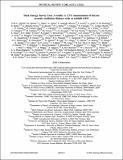Por favor, use este identificador para citar o enlazar a este item:
http://hdl.handle.net/10261/293152COMPARTIR / EXPORTAR:
 SHARE SHARE
 CORE
BASE CORE
BASE
|
|
| Visualizar otros formatos: MARC | Dublin Core | RDF | ORE | MODS | METS | DIDL | DATACITE | |

| Título: | Dark energy survey year 3 results: A 2.7% measurement of baryon acoustic oscillation distance scale at redshift 0.835 |
Autor: | Abbott, T. M. C.; Ávila, S.; Carretero, Jorge CSIC ORCID; Castander, Francisco J. CSIC ORCID; Fosalba, Pablo CSIC ORCID; García-Bellido, Juan CSIC ORCID; Gaztañaga, Enrique CSIC ORCID; Serrano, Sergio; Tutusaus, Isaac CSIC ORCID; DES Collaboration | Fecha de publicación: | 2022 | Editor: | American Physical Society | Citación: | Physical Review D 105(4): 043512 (2022) | Resumen: | We present angular diameter measurements obtained by measuring the position of baryon acoustic oscillations (BAO) in an optimized sample of galaxies from the first three years of Dark Energy Survey data (DES Y3). The sample consists of 7 million galaxies distributed over a footprint of 4100 deg2 with 0.6<zphoto<1.1 and a typical redshift uncertainty of 0.03(1+z). The sample selection is the same as in the BAO measurement with the first year of DES data, but the analysis presented here uses three times the area, extends to higher redshift, and makes a number of improvements, including a fully analytical BAO template, the use of covariances from both theory and simulations, and an extensive preunblinding protocol. We used two different statistics; angular correlation function and power spectrum, and validate our pipeline with an ensemble of over 1500 realistic simulations. Both statistics yield compatible results. We combine the likelihoods derived from angular correlations and spherical harmonics to constrain the ratio of comoving angular diameter distance DM at the effective redshift of our sample to the sound horizon scale at the drag epoch. We obtain DM(zeff=0.835)/rd=18.92±0.51, which is consistent with, but smaller than, the Planck prediction assuming flat ΛCDM, at the level of 2.3σ. The analysis was performed blind and is robust to changes in a number of analysis choices. It represents the most precise BAO distance measurement from imaging data to date, and is competitive with the latest transverse ones from spectroscopic samples at z>0.75. When combined with DES 3x2pt+SNIa, they lead to improvements in H0 and Ωm constraints by∼20%. | Descripción: | T. M.C. Abbott et al. | URI: | http://hdl.handle.net/10261/293152 | DOI: | 10.1103/PhysRevD.105.043512 | E-ISSN: | 2470-0029 |
| Aparece en las colecciones: | (ICE) Artículos (IFT) Artículos |
Ficheros en este ítem:
| Fichero | Descripción | Tamaño | Formato | |
|---|---|---|---|---|
| dark0835.pdf | 1,57 MB | Adobe PDF |  Visualizar/Abrir |
CORE Recommender
SCOPUSTM
Citations
38
checked on 20-abr-2024
WEB OF SCIENCETM
Citations
26
checked on 23-feb-2024
Page view(s)
40
checked on 07-may-2024
Download(s)
18
checked on 07-may-2024
Google ScholarTM
Check
Altmetric
Altmetric
NOTA: Los ítems de Digital.CSIC están protegidos por copyright, con todos los derechos reservados, a menos que se indique lo contrario.
